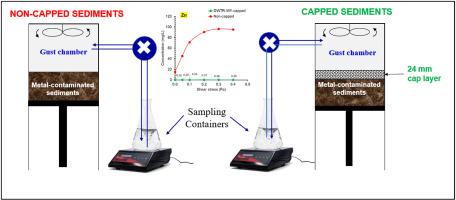评估将饮用水处理残留物作为金属污染沉积物的就地封盖材料。
IF 8.1
2区 环境科学与生态学
Q1 ENVIRONMENTAL SCIENCES
引用次数: 0
摘要
本研究利用 Gust-chamber 实验对饮用水处理残留物 (DWTR) 作为金属污染沉积物的原位覆盖材料进行了评估。在 0.05 至 0.4 Pa 的剪切应力(τ)不断增加的情况下,测量了未加盖沉积物和加盖 DWTR 的沉积物的金属释放量。在 96 小时的生物测定中,将黑头鲦鱼(FHM)幼鱼暴露于来自这些沉积物的水中,以评估 DWTR 在降低金属毒性方面的功效。沙子被用作惰性封盖材料进行比较。薄膜中的扩散梯度(DGT)评估了 DWTR 对沉积物孔隙水和上覆水中垂直金属浓度分布的影响,浓度由 ICP-MS 测定。在不覆砂的情况下,τ 的增加会使上覆水中镉和锌的金属浓度从 45 毫克/升上升到 95 毫克/升,铜的浓度从 4-10 毫克/升上升到 4 毫克/升,铅的浓度从 2-4 毫克/升上升到 2 毫克/升。覆沙降低了这些浓度,镉和锌的浓度从 4 毫克/升到 21 毫克/升,铜的浓度从 0.26 毫克/升到 0.63 毫克/升,铅的浓度从 0.051 毫克/升到 0.23 毫克/升。DWTR 覆层大大降低了上覆水中的金属浓度,镉含量从 1 微克/升到 8 微克/升,锌含量从 30 微克/升到 40 微克/升,铜含量从 2.5 微克/升到 5 微克/升,铅含量从 1 微克/升到 2 微克/升。因此,除了物理屏障效应外,DWTR 盖还通过其他机制(如吸附和沉淀)固定了金属。生物测定结果表明,DWTR 能显著降低金属对 FHM 的毒性,而砂盖和无盖沉积物则会导致 FHM 100%死亡。DGT 证实,DWTR 可将沉积物-水界面的金属通量降低两个数量级。本文章由计算机程序翻译,如有差异,请以英文原文为准。

Evaluating drinking water treatment residuals as an in-situ capping material for metal-contaminated sediments
This study evaluated drinking water treatment residuals (DWTR) as an in-situ capping material for metal-contaminated sediments using Gust-chamber experiments. Metal release from non-capped and DWTR-capped sediments was measured under increasing shear stress (τ) from 0.05 to 0.4 Pa. Fathead minnow (FHM) juveniles (Pimephales promelas) were exposed to water from these sediments in 96-h bioassays to assess DWTR's efficacy in reducing metal toxicity. Sand was used as an inert capping material for comparison. Diffusive gradients in thin films (DGT) assessed DWTR's impact on vertical metal concentration profiles in sediment pore water and overlying water, with concentrations determined by ICP-MS. Without capping, increasing τ raised metal concentrations in the overlying water from 45 to 95 mg/L for Cd and Zn, 4–10 mg/L for Cu, and 2–4 mg/L for Pb. Sand capping reduced these levels, with Cd and Zn ranging from 4 to 21 mg/L, Cu from 0.26 to 0.63 mg/L, and Pb from 0.051 to 0.23 mg/L. DWTR capping significantly lowered metal concentrations in the overlying water, with Cd ranging from 1 to 8 μg/L, Zn from 30 to 40 μg/L, Cu from 2.5 to 5 μg/L, and Pb from 1 to 2 μg/L. Therefore, beyond the physical barrier effect, the DWTR cap immobilizes metals through other mechanisms such as sorption and precipitation. Bioassays showed that DWTR significantly decreased metal toxicity to FHM, while sand-capped and non-capped sediments caused 100% mortality. DGT confirmed DWTR reduced metal fluxes at the sediment-water interface by up to two orders of magnitude.
求助全文
通过发布文献求助,成功后即可免费获取论文全文。
去求助
来源期刊

Chemosphere
环境科学-环境科学
CiteScore
15.80
自引率
8.00%
发文量
4975
审稿时长
3.4 months
期刊介绍:
Chemosphere, being an international multidisciplinary journal, is dedicated to publishing original communications and review articles on chemicals in the environment. The scope covers a wide range of topics, including the identification, quantification, behavior, fate, toxicology, treatment, and remediation of chemicals in the bio-, hydro-, litho-, and atmosphere, ensuring the broad dissemination of research in this field.
 求助内容:
求助内容: 应助结果提醒方式:
应助结果提醒方式:


